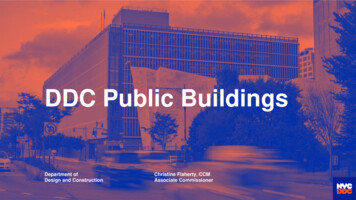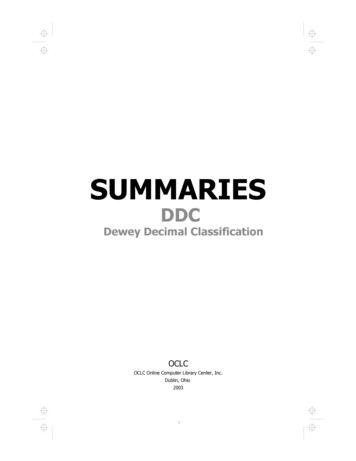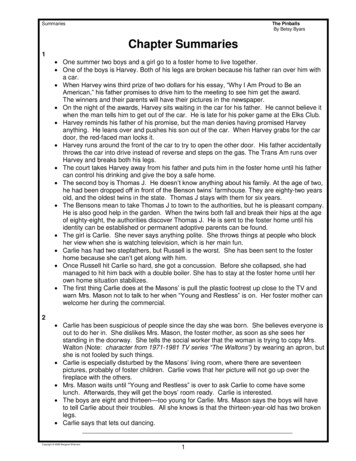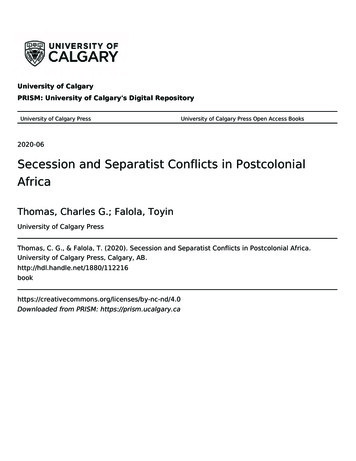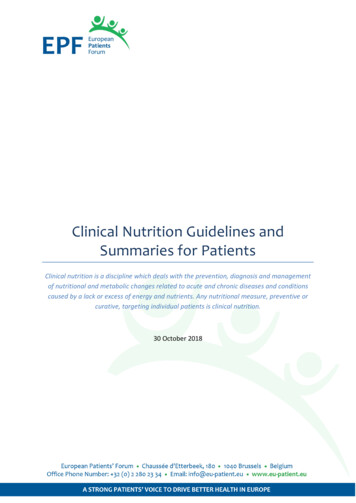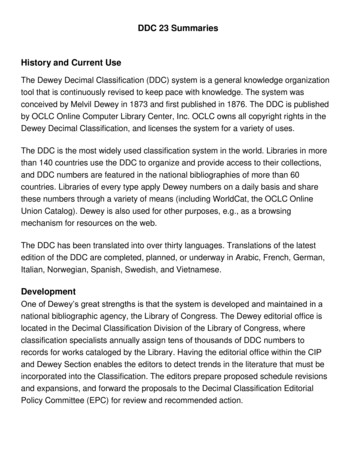
Transcription
DDC 23 SummariesHistory and Current UseThe Dewey Decimal Classification (DDC) system is a general knowledge organizationtool that is continuously revised to keep pace with knowledge. The system wasconceived by Melvil Dewey in 1873 and first published in 1876. The DDC is publishedby OCLC Online Computer Library Center, Inc. OCLC owns all copyright rights in theDewey Decimal Classification, and licenses the system for a variety of uses.The DDC is the most widely used classification system in the world. Libraries in morethan 140 countries use the DDC to organize and provide access to their collections,and DDC numbers are featured in the national bibliographies of more than 60countries. Libraries of every type apply Dewey numbers on a daily basis and sharethese numbers through a variety of means (including WorldCat, the OCLC OnlineUnion Catalog). Dewey is also used for other purposes, e.g., as a browsingmechanism for resources on the web.The DDC has been translated into over thirty languages. Translations of the latestedition of the DDC are completed, planned, or underway in Arabic, French, German,Italian, Norwegian, Spanish, Swedish, and Vietnamese.DevelopmentOne of Dewey’s great strengths is that the system is developed and maintained in anational bibliographic agency, the Library of Congress. The Dewey editorial office islocated in the Decimal Classification Division of the Library of Congress, whereclassification specialists annually assign tens of thousands of DDC numbers torecords for works cataloged by the Library. Having the editorial office within the CIPand Dewey Section enables the editors to detect trends in the literature that must beincorporated into the Classification. The editors prepare proposed schedule revisionsand expansions, and forward the proposals to the Decimal Classification EditorialPolicy Committee (EPC) for review and recommended action.
EPC is a ten-member international board whose main function is to advise the editorsand OCLC on matters relating to changes, innovations, and the general developmentof the Classification. EPC represents the interests of DDC users; its members comefrom national, public, special, and academic libraries, and from library schools.EditionsThe DDC is published in full and abridged editions in print and web accessibleversions. The abridged edition is a logical truncation of the notational and structuralhierarchy of the corresponding full edition on which it is based, and is intended forgeneral collections of 20,000 titles or less. WebDewey, the electronic version of theclassification is updated frequently and contain additional index entries and mappedvocabulary. Currently, the Abridged 15 edition is available to WebDewey subscribersin pdf form. Abridged numbers are indicated with segmentation marked. The electronicversion and supplemental web postings are the chief sources of ongoing updates tothe DDC. On the Dewey web site (www.oclc.org/dewey), selected new numbers andchanges to the DDC are posted regularly.Structure and NotationThe DDC is built on sound principles that make it ideal as a general knowledgeorganization tool: meaningful notation in universally recognized Arabic numerals, welldefined categories, well-developed hierarchies, and a rich network of relationshipsamong topics. In the DDC, basic classes are organized by disciplines or fields of study.At the broadest level, the DDC is divided into ten main classes, which together coverthe entire world of knowledge. Each main class is further divided into ten divisions, andeach division into ten sections (not all the numbers for the divisions and sections havebeen used). The main structure of the DDC is presented in the DDC Summariesfollowing this introduction. The headings associated with the numbers in thesummaries have been edited for browsing purposes, and do not necessarily match thecomplete headings found in the schedules.The first summary contains the ten main classes. The first digit in each three-digitnumber represents the main class. For example, 600 represents technology.The second summary contains the hundred divisions. The second digit in each threedigit number indicates the division. For example, 600 is used for general works ontechnology, 610 for medicine and health, 620 for engineering, 630 for agriculture.
The third summary contains the thousand sections. The third digit in each three-digitnumber indicates the section. Thus, 610 is used for general works on medicine andhealth, 611 for human anatomy, 612 for human physiology, 613 for personal healthand safety.Arabic numerals are used to represent each class in the DDC. A decimal point followsthe third digit in a class number, after which division by ten continues to the specificdegree of classification needed.A subject may appear in more than one discipline. For example, “clothing” has aspectsthat fall under several disciplines. The psychological influence of clothing belongs in155.95 as part of the discipline of psychology; customs associated with clothing belongin 391 as part of the discipline of customs; and clothing in the sense of fashion designbelongs in 746.92 as part of the discipline of the arts.HierarchyHierarchy in the DDC is expressed through structure and notation. Structural hierarchymeans that all topics (aside from the ten main classes) are part of all the broadertopics above them. Any note regarding the nature of a class holds true for all thesubordinate classes, including logically subordinate topics classed at coordinatenumbers.Notational hierarchy is expressed by length of notation. Numbers at any given level areusually subordinate to a class whose notation is one digit shorter; coordinate with aclass whose notation has the same number of significant digits; and superordinate to aclass with numbers one or more digits longer. The underlined digits in the followingexample demonstrate this notational hierarchy:600 TechnologyAgriculture and related technologies630Animal husbandry636636.7Dogs636.8Cats
“Dogs” and “Cats” are more specific than (i.e., are subordinate to) “Animal husbandry”;they are equally specific as (i.e., are coordinate with) each other; and “Animalhusbandry” is less specific than (i.e., is superordinate to) “Dogs” and “Cats.”Sometimes, other devices must be used to express the hierarchy when it is notpossible or desirable to do so through the notation. Special headings, notes, andentries indicate relationships among topics that violate notational hierarchy.Arrangement of the DDCThe print version of the latest full edition of the DDC, Edition 23, is composed of thefollowing major parts in four volumes:Volume 1(A) Introduction: A description of the DDC and how to use it(B) Glossary: Short definitions of terms used in the DDC(C) Index to the Introduction and Glossary(D) Manual: A guide to the use of the DDC that is made up primarily of extendeddiscussions of problem areas in the application of the DDC. Information in theManual is arranged by the numbers in the tables and schedules.(E) Tables: Six numbered tables of notation that can be added to class numbers toprovide greater specificityVolume 2(F) Schedules: The organization of knowledge from 000–599Volume 3(G) Schedules: The organization of knowledge from 600–999Volume 4(H) Relative Index: An alphabetical list of subjects with the disciplines in which they aretreated subarranged alphabetically under each entryEntriesEntries in the schedules and tables are composed of a DDC number in the numbercolumn (the column at the left margin), a heading describing the class that the number
represents, and often one or more notes. All entries (numbers, headings, and notes)should be read in the context of the hierarchy.In the print version of the DDC, the first three digits of schedule numbers (mainclasses, divisions, sections) appear only once in the number column, when first used.They are repeated at the top of each page where their subdivisions continue.Subordinate numbers appear in the number column, beginning with a decimal point,with the initial three digits understood.Some numbers in the schedules and tables are enclosed in parentheses or squarebrackets. Numbers and notes in parentheses provide options to standard practice.Numbers in square brackets represent topics that have been relocated ordiscontinued, or are unassigned. Square brackets are also used for standardsubdivision concepts that are represented in another location. Numbers in squarebrackets are never used.Number BuildingOnly a fraction of potential DDC numbers are included in the schedules. It is oftennecessary to build or synthesize a number that is not specifically listed in theschedules. Such built numbers allow for greater depth of content analysis. There arefour sources of notation for building numbers: (A) Table 1 Standard Subdivisions; (B)Tables 2–6; (C) other parts of the schedules; and (D) add tables in the schedules.Number building is initiated only upon instructions in the schedules (except for theaddition of standard subdivisions, which may take place anywhere unless there is aninstruction to the contrary). Number building begins with a base number (always statedin the instruction note) to which another number is added.More InformationThe Dewey web site (www.oclc.org/dewey) contains up-to-date information about theDDC, DDC products and services, and DDC licensing. For more information about thestructure and application of the Dewey Decimal Classification, consult the Introduction.A more in-depth introduction to the Dewey Decimal Classification may be found on theDewey Teaching Site at http://oc.lc/deweyteachingsite
DDC 23 SummariesMain Classes000100200300400500600700800900Computer science, information & general worksPhilosophy & psychologyReligionSocial sciencesLanguageScienceTechnologyArts & recreationLiteratureHistory & geographyConsult schedules for complete and exact headings
Second SummaryHundred 470480490Computer science, knowledge & systemsBibliographiesLibrary & information sciencesEncyclopedias & books of facts[Unassigned]Magazines, journals & serialsAssociations, organizations & museumsNews media, journalism & publishingQuotationsManuscripts & rare gy & occultismPhilosophical schools of thoughtPsychologyPhilosophical logicEthicsAncient, medieval & eastern philosophyModern western philosophyReligionPhilosophy & theory of religionThe BibleChristianityChristian practice & observanceChristian pastoral practice & religious ordersChristian organization, social work & worshipHistory of ChristianityChristian denominationsOther religionsSocial sciences, sociology & anthropologyStatisticsPolitical scienceEconomicsLawPublic administration & military scienceSocial problems & social servicesEducationCommerce, communications & transportationCustoms, etiquette & folkloreLanguageLinguisticsEnglish & Old English languagesGerman & related languagesFrench & related languagesItalian, Romanian & related languagesSpanish, Portuguese, GalicianLatin & Italic languagesClassical & modern Greek languagesOther languagesConsult schedules for complete and exact yEarth sciences & geologyFossils & prehistoric lifeBiologyPlants (Botany)Animals (Zoology)TechnologyMedicine & healthEngineeringAgricultureHome & family managementManagement & public relationsChemical engineeringManufacturingManufacture for specific usesConstruction of buildingsArtsArea planning & landscape architectureArchitectureSculpture, ceramics & metalworkGraphic arts & decorative artsPaintingPrintmaking & printsPhotography, computer art, film, videoMusicSports, games & entertainmentLiterature, rhetoric & criticismAmerican literature in EnglishEnglish & Old English literaturesGerman & related literaturesFrench & related literaturesItalian, Romanian & related literaturesSpanish, Portuguese, Galician literaturesLatin & Italic literaturesClassical & modern Greek literaturesOther literaturesHistoryGeography & travelBiography & genealogyHistory of ancient world (to ca. 499)History of EuropeHistory of AsiaHistory of AfricaHistory of North AmericaHistory of South AmericaHistory of other areas
Third SummaryThousand 46047048049Computer science, information, general worksKnowledgeThe bookSystemsComputer scienceComputer programming, programs, data, securitySpecial computer raphyBibliographies and catalogsBibliographies and catalogs of individuals[Unassigned]Of anonymous & pseudonymous worksOf works from specific placesOf works on specific subjectsOf works held in specific collections or offered for sale[Unassigned][Unassigned]Library and information sciencesRelationships of libraries and archivesAdministration of physical plantPersonnel management[Unassigned]Operations of libraries and archivesLibraries and archives devoted to specific subjectsGeneral libraries and archivesReading and use of other information media[Unassigned]General encyclopedic worksGeneral encyclopedic works in American EnglishGeneral encyclopedic works in EnglishEncyclopedias in other Germanic languagesEncyclopedias in French, Occitan, CatalanEncyclopedias in Italian, Romanian & related languagesEncyclopedias in Spanish, Portuguese, GalicianGeneral encyclopedic works in Slavic languagesGeneral encyclopedic works in Scandinavian languagesGeneral encyclopedic works in other gned][Unassigned][Unassigned]Consult schedules for complete and exact 97098099General serial publicationsGeneral serial publications in American EnglishGeneral serial publications in EnglishSerials in other Germanic languagesSerials in French, Occitan, CatalanSerials in Italian, Romanian & related languagesSerials in Spanish, Portuguese, GalicianGeneral serial publications in Slavic languagesSerials in Scandinavian languagesGeneral serial publications in other languagesGeneral organizations and museologyGeneral organizations in North AmericaGeneral organizations in British IslesGeneral organizations in GermanyGeneral organizations in France and MonacoGeneral organizations in ItalyGeneral organizations in SpainGeneral organizations in RussiaGeneral organizations in other geographic areasMuseology (Museum science)Documentary, educational, news media; journalismJournalism and newspapers in North AmericaJournalism and newspapers in British IslesJournalism and newspapers in GermanyJournalism and newspapers in France and MonacoJournalism and newspapers in ItalyJournalism and newspapers in SpainJournalism and newspapers in RussiaJournalism and newspapers in ScandinaviaNewspapers in other geographic areasGeneral collectionsGeneral collections in American EnglishGeneral collections in EnglishGeneral collections in other Germanic languagesGeneral collections in French, Occitan, CatalanCollections in Italian, Romanian & related languagesCollections in Spanish, Portuguese, GalicianGeneral collections in Slavic languagesGeneral collections in Scandinavian languagesGeneral collections in other languagesManuscripts, rare booksManuscriptsBlock booksIncunabulaPrinted booksBooks notable for bindingsBooks notable for illustrations and materialsBooks notable for ownership or originProhibited works, forgeries, hoaxesBooks notable for format
149Philosophy & psychologyTheory of philosophyMiscellany of philosophyDictionaries & encyclopedias[Unassigned]Serial publications of philosophyOrganizations & managementEducation, research & related topicsGroups of peopleHistory and collected biographyMetaphysicsOntology[Unassigned]Cosmology (Philosophy of nature)SpaceTimeChangeStructureForce and energyNumber and quantityEpistemology, causation, humankindEpistemology (Theory of knowledge)CausationDeterminism and indeterminismTeleology[Unassigned]The selfThe unconscious and the subconsciousHumankindOrigin and destiny of individual soulsParapsychology and occultismParapsychological and occult methods[Unassigned]Specific topics in parapsychology & occultism[Unassigned]Dreams and mysteries[Unassigned]Divinatory graphologyPhysiognomyPhrenologySpecific philosophical schoolsIdealism and related systemsCritical philosophyBergsonism and intuitionismHumanism and related systemsSensationalismNaturalism and related systemsPantheism and related systemsDogmatism, eclecticism, liberalism, etc.Other philosophical systems and doctrinesConsult schedules for complete and exact 97198199Psychology[Unassigned]Perception, movement, emotions & drivesConscious mental processes & intelligenceSubconscious & altered statesDifferential & developmental psychologyComparative psychology[Unassigned]Applied psychology[Unassigned]Philosophical lacies and sources of errorSyllogismsHypothesesArgument and persuasionAnalogyEthics (Moral philosophy)Ethical systemsPolitical ethicsEthics of family relationshipsOccupational ethicsEthics of recreation & leisureEthics of sex and reproductionEthics of social relationsEthics of consumptionOther ethical normsAncient, medieval, eastern philosophyEastern philosophyPre-Socratic Greek philosophiesSophistic, Socratic, related philosophiesPlatonic philosophyAristotelian philosophySkeptic and Neoplatonic philosophiesEpicurean philosophyStoic philosophyMedieval western philosophyModern western philosophyPhilosophy of United States and CanadaPhilosophy of British IslesPhilosophy of Germany and AustriaPhilosophy of FrancePhilosophy of ItalyPhilosophy of Spain and PortugalPhilosophy of RussiaPhilosophy of Scandinavia and FinlandPhilosophy of other geographic areas
249ReligionReligious mythology & social theologyDoctrinesPublic worship and other practicesReligious experience, life, practiceReligious ethicsLeaders and organizationMissions and religious educationSourcesSects and reform movementsPhilosophy and theory of religionConcepts of GodExistence, knowability & attributes of GodCreationTheodicyScience and ed]BibleOld Testament (Tanakh)Historical books of Old TestamentPoetic books of Old TestamentProphetic books of Old TestamentNew TestamentGospels and ActsEpistlesRevelation (Apocalypse)Apocrypha and pseudepigraphaChristianityGodJesus Christ and his familyHumankindSalvation and graceSpiritual beingsEschatology[Unassigned]Creeds & catechismsApologetics and polemicsChristian moral and devotional theologyChristian ethicsDevotional literatureEvangelistic writings for individuals[Unassigned][Unassigned]Use of art in ChristianityChurch furnishings and related articlesChristian experience, practice, lifeChristian observances in family lifeConsult schedules for complete and exact 97298299Local Christian church and religious ordersPreaching (Homiletics)Texts of sermonsPastoral work (Pastoral theology)Local church administrationReligious congregations and orders[Unassigned][Unassigned][Unassigned]Pastoral care of families & kinds of personsChristian social and ecclesiastical theologySocial theology and interreligious relationsEcclesiologyDays, times, places of religious observancePublic worshipSacraments, other rites and actsMissionsAssociations for religious workReligious educationSpiritual renewalHistory, geographic treatment, biographyReligious orders in church historyPersecutions in general church historyDoctrinal controversies & heresiesHistory of Christianity in EuropeHistory of Christianity in AsiaHistory of Christianity in AfricaHistory of Christianity in North AmericaHistory of Christianity in South AmericaHistory of Christianity in other areasDenominations & sects of Christian churchEarly church and Eastern churchesRoman Catholic ChurchAnglican churchesProtestants of Continental originPresbyterian, Reformed & CongregationalBaptist, Restoration & AdventistMethodist and related churches[Unassigned]Other denominations and sectsOther religions[Unassigned]Classical religion (Greek & Roman religion)Germanic religionReligions of Indic originZoroastrianism (Mazdaism, Parseeism)JudaismIslam, Babism & Bahai Faith(Optional number)Religions not provided for elsewhere
349Social sciencesSociology and anthropologySocial interactionSocial processesFactors affecting social behaviorGroups of peopleCulture and lections of general ral statistics of EuropeGeneral statistics of AsiaGeneral statistics of AfricaGeneral statistics of North AmericaGeneral statistics of South AmericaGeneral statistics of other areasPolitical science (Politics and government)Systems of governments and statesRelation of state to organized groupsCivil and political rightsThe political processInternational migration and colonizationSlavery and emancipationInternational relationsThe legislative process[Unassigned]EconomicsLabor economicsFinancial economicsEconomics of land and energyCooperativesSocialism and related systemsPublic financeInternational economicsProductionMacroeconomics and related topicsLawLaw of nationsConstitutional and administrative lawMilitary, tax, trade & industrial lawLabor, social, education & cultural lawCriminal lawPrivate lawProcedure and courtsLaws, regulations, casesLaw of specific jurisdictions & areasConsult schedules for complete and exact 97398399Public administration and military sciencePublic administrationGeneral considerations of public administrationSpecific fields of public administrationAdministration of economy & environmentMilitary scienceFoot forces & warfareMounted forces & warfareAir & other specialized forcesSea forces and warfareSocial problems and services; associationsSocial problems and servicesSocial problems and services to groupsOther social problems and servicesCriminologyPenal and related institutionsSecret associations and societiesGeneral clubsInsuranceAssociationsEducationSchools and their activities; special educationPrimary education (Elementary education)Secondary educationAdult educationCurricula[Unassigned][Unassigned]Higher education (Tertiary education)Public policy issues in educationCommerce, communications, transportationCommerce (Trade)International commerce (Foreign trade)Postal communicationCommunicationsRailroad transportationInland waterway and ferry transportationWater, air, space transportationTransportationMetrology and standardizationCustoms, etiquette, folkloreCostume and personal appearanceCustoms of life cycle and domestic lifeDeath customsGeneral customsEtiquette (Manners)[Unassigned][Unassigned]FolkloreCustoms of war and diplomacy
449LanguagePhilosophy and theoryMiscellanyDictionaries & encyclopediasSpecial topics of languageSerial publicationsOrganizations and managementEducation, research, related topicsGroups of peopleGeographic treatment and biographyLinguisticsWriting systemsEtymologyDictionariesPhonology & phoneticsGrammar[Unassigned]Dialectology and historical linguisticsApplied linguisticsSign languagesEnglish & Old English (Anglo-Saxon)Writing system, phonology, phoneticsEtymology of standard EnglishDictionaries of standard English[Unassigned]Grammar of standard English[Unassigned]English language variationsStandard English usageOld English (Anglo-Saxon)German and related languagesWriting system, phonology, phoneticsEtymology of standard GermanDictionaries of standard German[Unassigned]Grammar of standard German[Unassigned]German language variationsStandard German usageOther Germanic languagesFrench & related Romance languagesWriting system, phonology, phoneticsEtymology of standard FrenchDictionaries of standard French[Unassigned]Grammar of standard French[Unassigned]French language variationsStandard French usageOccitan, Catalan, Franco-ProvençalConsult schedules for complete and exact 97498499Italian, Romanian & related languagesWriting system, phonology, phoneticsEtymology of standard ItalianDictionaries of standard Italian[Unassigned]Grammar of standard Italian[Unassigned]Italian language variationsStandard Italian usageRomanian, Rhaetian, Sardinian, CorsicanSpanish, Portuguese, GalicianWriting system, phonology, phoneticsEtymology of standard SpanishDictionaries of standard Spanish[Unassigned]Grammar of standard Spanish[Unassigned]Spanish language variationsStandard Spanish usagePortugueseLatin and related Italic languagesWriting system, phonology, phoneticsEtymology of classical LatinDictionaries of classical Latin[Unassigned]Grammar of classical Latin[Unassigned]Old, postclassical, Vulgar LatinClassical Latin usageOther Italic languagesClassical Greek; Hellenic languagesWriting system, phonology, phoneticsEtymology of classical GreekDictionaries of classical Greek[Unassigned]Grammar of classical Greek[Unassigned]Preclassical and postclassical GreekClassical Greek usageOther Hellenic languagesOther languagesEast Indo-European and Celtic languagesAfro-Asiatic languagesNon-Semitic Afro-Asiatic languagesAltaic, Uralic, Hyperborean & DravidianLanguages of east and southeast AsiaAfrican languagesNorth American native languagesSouth American native languagesAustronesian & other languages
549Natural sciences and mathematicsPhilosophy and theoryMiscellanyDictionaries & encyclopedias[Unassigned]Serial publicationsOrganizations and managementEducation, research, related topicsNatural historyHistory, geographic treatment, biographyMathematicsGeneral principles of ry[Unassigned]Numerical analysisProbabilities and applied mathematicsAstronomy and allied sciencesCelestial mechanicsTechniques, equipment & materialsSpecific celestial bodies and phenomena[Unassigned]Earth (Astronomical geography)Mathematical geographyCelestial navigationEphemeridesChronologyPhysicsClassical mechanicsFluid mechanicsPneumatics (Gas mechanics)Sound and related vibrationsLight and related radiationHeatElectricity and electronicsMagnetismModern physicsChemistry and allied sciencesPhysical chemistryTechniques, equipment & materialsAnalytical chemistry[Unassigned][Unassigned]Inorganic chemistryOrganic chemistryCrystallographyMineralogyConsult schedules for complete and exact 97598599Earth sciencesGeology, hydrology, meteorologyPetrologyEconomic geologyEarth sciences of EuropeEarth sciences of AsiaEarth sciences of AfricaEarth sciences of North AmericaEarth sciences of South AmericaEarth sciences of other areasPaleontologyPaleobotany; fossil microorganismsFossil invertebratesFossil marine & seashore invertebratesFossil Mollucas & MolluscoideaFossil ArthropodaFossil ChordataFossil cold-blooded vertebratesFossil Aves (birds)Fossil MammaliaBiologyPhysiology & related subjectsBiochemistrySpecific physiological systems in animals[Unassigned]Specific parts of & systems in plantsGenetics and evolutionEcologyNatural history of organismsMicroorganisms, fungi & algaePlantsSpecific topics in natural history of plantsPlants noted for characteristics & flowersEudicots and CeratophyllalesMonocots, Chloranthales, a[Unassigned]AnimalsSpecific topics in natural history of animalsInvertebratesMarine & seashore invertebratesMollusca and MolluscoideaArthropodaChordataCold-blooded vertebratesAvesMammalia
649Technology (Applied sciences)Philosophy and theoryMiscellanyDictionaries, encyclopedias, concordancesTechnical drawing, hazardous materialsSerial publicationsOrganizationsEducation, research, related topicsPatentsHistory, geographic treatment, biographyMedicine and healthHuman anatomy, cytology, histologyHuman physiologyPersonal health & safetyForensic medicine; incidence of diseasePharmacology and therapeuticsDiseasesSurgery & related medical specialtiesGynecology,
by OCLC Online Computer Library Center, Inc. OCLC owns all copyright rights in the Dewey Decimal Classification, and licenses the system for a variety of uses. The DDC is the most widely used classification system in the world. Libraries in more than 140 countries use the

